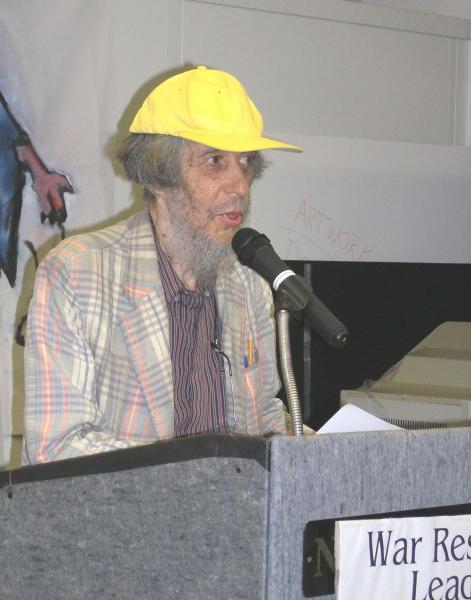Nephtali (Tuli) Kupferberg, 1923–2010

Many titles and labels have been ascribed to Tuli: artist, poet, rock star, counterculture guru, beat, yippie, bohemian, anarchist, and pacifist. It is difficult to write about a man born the same year as WRL whose gentle heart and keen political insight produced over 60 years of art. Tuli was the quintessential non-dualist: he lived peace; he was art. WRL friend Ellen Davidson called him “a force of nature.” He passed away on July 12 at age 86.
Born September 28, 1923, into a Yiddish-speaking family, Tuli, a cum laude graduate from Brooklyn College, had access to the “American Dream” working as a medical librarian. However, he rejected peace sought through war and the emerging Cold War consensus culture and moved to the East Village, where he began living the bohemian life and publishing his and other beat poets’ writings in his underground magazines Birth and Yeah. During the early 1960s, he wrote about peace and authenticity in publications such as 1001 Ways to Live Without Working and 1001 Ways to Beat the Draft.
In late 1964, Tuli formed a rock band, the Fugs, with Peace eye Bookstore owner Ed Sanders. In 1965, the Fugs started playing local venues in the Village, and by June 1, 1968, they were introduced at the Filmore east as the group responsible for a “great deal of the new York scene.” NYC WRL member Mayer Vishner recalled how dramatic it was for him, a 15-year-old who grew up in the repressive 1950s, to see the Fugs in 1965. He called Fugs’ song “Kill for Peace” the “greatest anarchist-pacifist song of the last part of the 20th century.”
Their lyrics and political actions kept the band from getting mainstream exposure, yet their performances at local venues, theaters, universities, student conferences, and national rallies—such as the 1967 Pentagon demonstrations, where the Fugs led the crowd in exorcising the demons from the building—greatly contributed to building a national peace movement in the ‘60s. As Tuli said, “We were the USO of the Left.” The Fugs’ influence extended beyond the New York scene, though, and their performances at venues across the middle and southern United States and their influence on students and organizers cannot be underestimated. Ray Lyndsy, a former student organizer at Southern Illinois University (which closed due to protests over Kent State), recalled seeing the Fugs along with David Harris and Timothy Leary at a conference for student body presidents. He called the Fugs “iconoclastic.”
The Fugs marched in the 1966 Anti-War New York Peace march and always lent their support and talents to peace organizations, particularly WRL. Susan Cakers recalled the Fugs playing a benefit concert to help pay for WRL’s newly acquired building at 339 Lafayette Street. Tuli continued writing, drawing, and supporting WRL until his decline in health. He loved WRL staffers Ralph DiGia and Karl Bissinger and attended their 90th birthday party. He’d drop by the office for literature, and he participated in the 2004 Peace Calendar party where, instead of reading his work, he had everyone singing.
Tuli was a force of nature and an inspiration to all. Mayer Vishner said, “Tuli made participation look easy and worthwhile.” Thanks, Tuli, for encouraging us to think, act, Be, love, and laugh.
—Deidre Hughes
